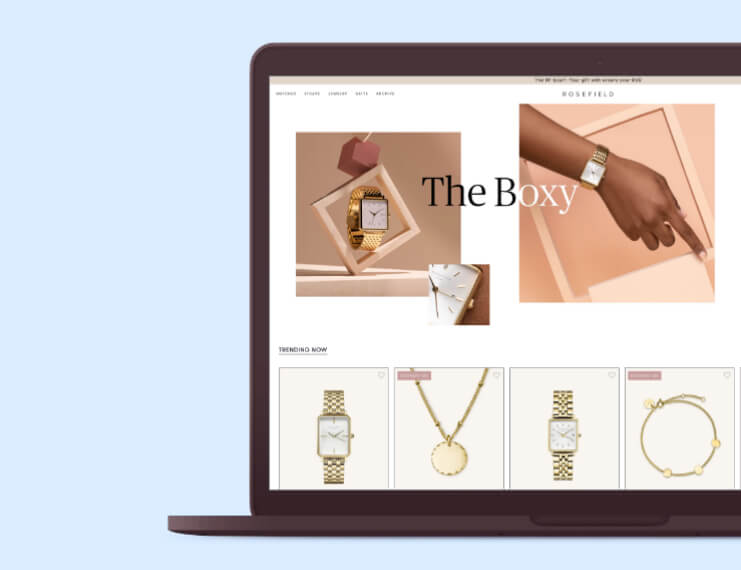Recap: the formula for e-commerce growth
In Part I of this blog series we introduced the e-commerce growth formula to explain how switching from an acquisition- to a retention-mindset works:
Revenue = Frequency x Average Order Value x Customer Count (Traffic x Conversion Rate)
Which means that, if your goal is to grow your revenue, you have four levers to achieve this:
- Frequency: how often your customers place an order
- Average Order Value: how much they spend per order
- Traffic: how many people visit your store
- Conversion Rate: the percentage of visitors that actually buy something
And if customer retention is your preferred tactic, your focus will be on improving Frequency and Average Order Value.
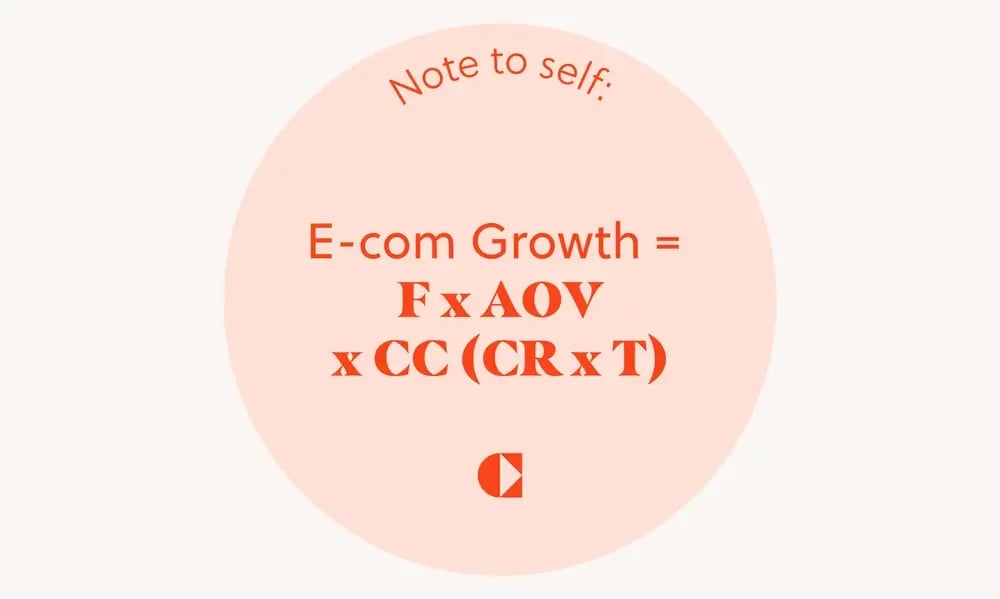
Why you need better customers
We can imagine the formula above might feel to you like a bunch of marketing theory that doesn’t really come alive. What does focusing on improving Frequency and Average Order Value actually mean? Allow us to present this in a different way - a way that puts the focus back on people, instead of numbers. When we tell you to stop buying traffic and start focusing on retention, what we really mean is this.
You don't need more customers: you need better ones.
You need to mould your existing audience into the type of generous, reliable customers you want for your business. Remember what we said in that earlier blog about investing in retention? Great customers are made, not born. In every crappy, expensive customer who leaves you after returning the one purchase they made in your store, there is a wonderfully generous and loyal brand ambassador waiting to come out.
What separates the one from the other? Your efforts in facilitating that inner brand ambassador. It’s not them, it’s you. Wait, we’ve got a Seth Godin quote for you that sums it up nicely:
“The reason it seems that price is all your customers care about is that you haven’t given them anything else to care about.”
If you can give your customers a good reason to care about you and your brand, we can guarantee you will be amazed by all the love you will receive - and by the effect on your revenue and profit margin.
How to get better customers (and improve Frequency)
So how do you achieve that? There’s tons of words written on the subject, often riddled with e-com lingo and abbreviations. But the basic mechanism is simple humanity: win your customers’ affection. Check in regularly, be interested in them, be entertaining, and remember what they like. You don’t need a marketing degree for that.
In this blog we will refer to the e-com lingo wherever it is helpful, but keep in mind the bottom line: help your customer to be a great customer wherever you can. And the primary way to do this is by implementing structural re-engagement mechanisms. Meaning: make it very easy and attractive for your customers to shop with you more than once.
As a side-effect, this will improve your Frequency (the F in the growth formula we mentioned above). Frequency is the average number of times a customer orders something from you in a certain period of time. Or, to put it in yet another neat formula:
Frequency = Total orders / Total unique customers*
* Shopify merchants can easily find this number in their dashboards, under Reports > Sales by Customer.
We understand that if you just started out with your business, customer retention is not a top priority. There’s not much to retain if you don’t have customers yet, obviously. Hence, you need to focus on finding customers first - but even then it’s worth your while to already start implementing some retention strategies, with an eye to the future.
Even a small improvement in retention can have a big impact in the long run, as you can see below:
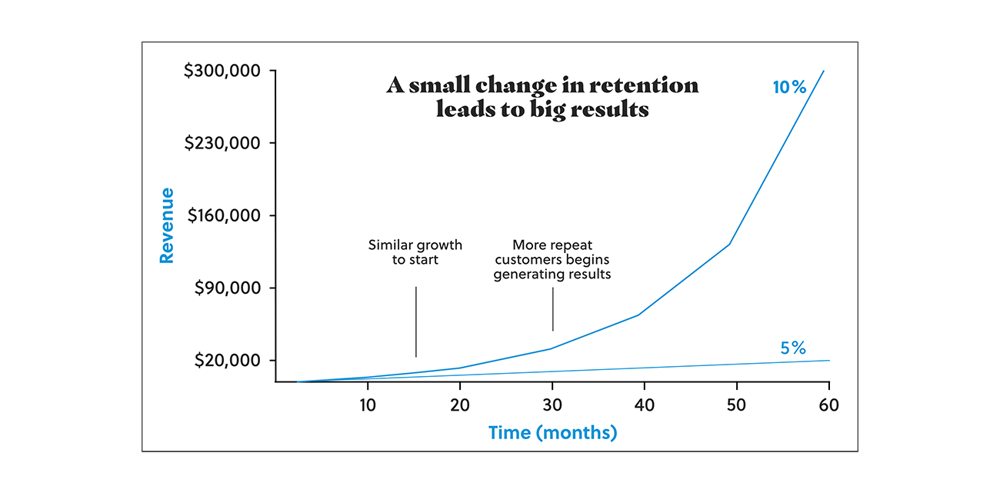
It’s also worth noting how much cheaper repeat customers are than new ones. We’ll give you a benchmark: attracting a new customer is anywhere between 5 to 25 times more expensive than getting an existing customer to place an order. With existing customers you don’t have acquisition costs, they return their orders less often (especially if you offer them the option to exchange), they usually spend more, and as a bonus they might refer other people to your store.
But let’s move away from the numbers again and get back to the people: how do you make it easy and attractive for your customers to shop with you more than once? There’s three basic strategies for that which we will discuss in detail below (with lots of hands-on tips!):
Be an excellent communicator
What is the number one characteristic of a good relationship? You said it: communication. To keep your customers around, you need to talk to them. As often as you can, but more importantly: as often as they would like you to.
How do you talk to your customers? Via email. Study after study shows that email marketing is still the best converting type of marketing around. So if you have anything to say, send your customers an email.
What do you talk about? Whatever it is that might interest your customers, and particularly stuff that makes them want to go to your webshop and buy something. So, are you launching a new product, do you want to offer a nice flat discount or did your customer abandoned their cart during their last visit? Send them an email.
Better yet: automate the hell out of those emails, preferably by using Klaviyo.
As it happens, Code is one of the most experienced agencies when it comes to Klaviyo email marketing. As one of the very few Platinum Klaviyo Partners in Europe, we know first-hand how much of a game changer automated email marketing is. So if you want to grow your revenue, our very first tip is:
Tip 1: Start using automated email marketing
Take it from us: automated email marketing is a must for your e-commerce brand. It takes a bit of thought to set it up, but then it easily brings in 20% of your revenue (and probably more).
If you want to help your customer to be the best customer they can, you will have to tip them off on everything you do - so that they know, and have a chance to enthusiastically join in whatever you’ve been up to. Not only that: you will generally have to be a good friend to them as well. Remember their birthday, help them out if they couldn’t finish the checkout and left their cart, tell them when an item they want is back in stock, tell them when they can expect a sale, anticipate any questions they might have about your products… the list goes on.
All of this you can do via email. What is more: all of these actions can be automated. And if you segment your email list cleverly and use the right software, these emails can be highly personalised too. The longer you work with email automation, the more tailor-made for the individual customer it can become.
Are you interested in a bunch of useful tips and tricks on how to set up and improve your email marketing? Make sure to read our Email Marketing Inspiration Book. It has tons of ideas on how to communicate with your customers and keep them coming back.

Tip 2: Keep your communication as personal as possible
If you really want to build a personal relationship with your customers, you should make your communication personal too. People tend to respond very well to brands that have a face and a voice and a recognizable character. If your business lends itself to it, try to become your brand. Merge with it.
Even better: make your brand the natural extension of its founder (or other important human(s) behind it). At Code we see Gisou and Fascino Coffee do this extremely well, and we think it’s THE way to win your audience for the long haul.
Tell them a bit about your brand and business in your emails (a welcome series flow in Klaviyo would be good for this), show your face, share your journey as an entrepreneur, ask them what they would like to see in your store, sign your emails with your own name and open with your customer’s first name, and make sure to reply when they send you any emails in return. Of course if the customer reaches out to you via another channel, you should reply as well - but more about that below, when we discuss customer support.


Tip 3: Check most opened/best-converting/best performing emails
If you are already using some form of email marketing, check how all your different emails are performing. Which ones are doing really well in terms of clickthrough rates? Why is that? And can you make them perform even better?
Which emails could use some more pizzazz? Test different adjustments and see if you can make them perform a little bit better. Start with e-mails that react to an action from the customer: an abandoned cart or checkout, a newsletter subscription or a purchase all mean that the customer is interested in your products. Try a different timing on these follow-up emails, or change the subject line or the body text, and take it from there.
Tip 4: Ask for feedback and/or reviews
Communication is a two-way street. Most of your emails to customers are about you giving them information - but you also want your customer to give you information every once in a while, so you know how to better facilitate their inner brand ambassador. How do they like your store, your products, your service? Is there something that they miss, is there room for improvement, what would they like to see? Ask them in an email, and reward them for their feedback through your loyalty program, if you have one (if you don’t, move to tip #8 below!).
Did you know customers that read authentic reviews are 4x more likely to convert into paying customers and have an average 28% higher basket value? Your customers love to see that others are raving about the product they are looking to buy. So besides valuable feedback it’s also a great way to crank up your CR and AOV!
One of our favorite solutions to help you gather and display text and video reviews for your Shopify store is Reviews.io.
Reviews.io has integrations with a few of our other favorite Shopify apps like Gorgias (helping your customer support team to respond to reviews), LoyaltyLion (reward consumers who leave reviews on your store) and Klaviyo (send automatic review requests, create segments with data from Reviews.io and create trust by incorporating reviews into your emails).
And, crucially:
Tip 5: React personally to feedback or negative experiences
Reply to any feedback you get! Just go completely over and beyond in helping out a customer with an issue. This is the best way to show your customer that you care about them and the product or service they received. Nice bonus: a customer whose problem you helped solve is a loyal customer forever. Even if there is no problem, a simple interaction on social media can already turn a customer into a repeat customer.
Because every extra minute spent on customer support means losing a customer, we advise using Gorgias. Hands down the best helpdesk platform for Shopify stores. Why? Imagine having your whole client history in one place, including order history and automatic answers to questions. This app will save you tons of time and realize a 20-30% conversion rate on answering tickets. Let's turn your customer service into a profit centre.
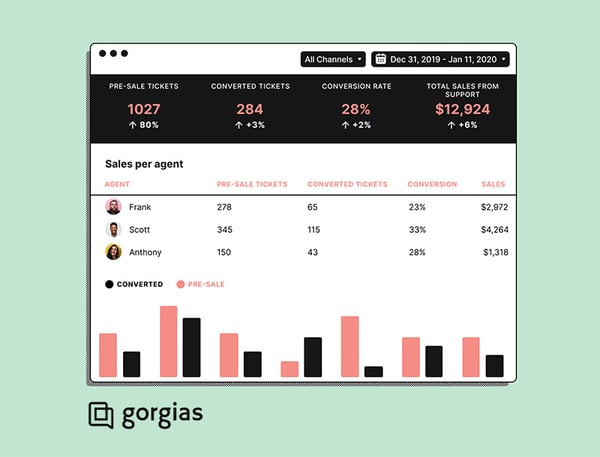
We know it’s a challenge sometimes, and you would really prefer to just think of a customer as a complete idiot. Before you do that, chew on this quote from Peep Laja a bit.
“Every ‘mistake’ a user makes is not because they’re stupid, but because your website sucks.”
Remember: people who make the effort of telling you how they experience your brand and store and products are worth their weight in gold. This is exactly the kind of information you need from your customers! See if you can reward them, enrol them in a user panel, or use your loyalty program (more about those below) to encourage feedback.
Give customers a reason to buy regularly
The most effective way to make customers return is to give them a very good reason to do so. What incentive can you offer them to keep an eye on your store? What is happening there that is of continuous interest to them? Here’s three ideas:
Tip 6: Drop new products at regular intervals
Keep your customers interested by offering new products at regular intervals. That way you train your customers to expect a product drop at certain times, which will bring them back to your store on a regular basis. This works very well in the fashion branche, where you can introduce a new capsule collection every week or month. Use email marketing and social media to promote it, and track and analyse the results. Patta and Na-kd are great examples of brands who get this right.
Tip 7: Offer subscriptions
Do you offer products that regularly need replacing, like a toothbrush (Boombrush), deodorant or coffee (like our client Fascino), flowers? Make your customers’ lives easier by offering a subscription service: deliver a replacement of their product at regular intervals, without them having to lift a finger. Even for products that don’t need replacement soon, leasing concepts can be an interesting business model. We helped MUD Jeans implement Firmhouse to realize their lease-a-jeans solution. Read more about that in our MUD Jeans case study.
You can use apps like Firmhouse or ReCharge to set this up in your Shopify admin.
Tip 8: Offer a loyalty program
Give your customers the opportunity to become a member of your VIP club. Have them collect loyalty points or credits with whatever actions you want to reward (buying products on a regular basis, recommending your brand to a friend, spending more than a certain amount, leaving a review: the options are endless), which they can exchange for all kinds of sweet presents (free shipping, a discount, exclusive or early access to a new product, a meet & greet, an actual gift… you can get creative here!). With apps like Loyalty Lion and Yotpo this is easily set up in Shopify.


Improve your customers’ experience
What can you offer in addition to your products that will please customers? Making their interaction with you as nice as possible. This is not exactly a single item on your to-do-list, though. Think of it more as a mindset: facilitating customers is an ongoing, core task of online businesses that takes continuous effort, lots and lots of tweaking, testing and finetuning, and some pure dedication.
Before you start mapping all the touchpoints in your entire customer experience (more about that in tip #14), you might want to get your toe in the water with a few smaller interventions though. Here are some ideas to get you started:
Tip 9: Amaze your customers
People like to marvel at things, be surprised, gently kicked out of their daily routine by something unexpected and fun and/or awe-inspiring! If you can do this for your customers, they will love you for it. An amazed customer becomes a little kid: they will trust you and follow you around wide-eyed with anticipation wherever you go.
So take some time to think about ways in which you can make your customers marvel: Launching a new product with a bang? Invest in quality storytelling through video, email or social media? Customer support people that really goes the extra mile? Involving your customers with some kind of treasure hunt or advent calendar? Have fun brainstorming!
Tip 10: Give them a present, or add a personal touch to their order
One way to amaze your customers is to do something extra. Like including a little present in their order, or a handwritten postcard with a personal message. Even though many brands do this nowadays, it never stops pleasing people. It just goes to show that you can hardly go wrong with the personal touch.
Looking for a good present that is also on brand? Think samples, stickers, postcards or a cool poster (keep this up for a few years and people will start collecting them) or small gift that perfectly accompanies your product. Find yourself a creative partner and think out of the box!
Tip 11: Check where customers leave (and why)
In addition to finding fun ways of surprising your customers, make sure you keep an eye on their behaviour and follow the data as well. What are customers doing while in your store, where do they regularly give up, and why is that? Formulate hypotheses and test them one by one, ask your customers directly, check with your support crew - and fix those bottlenecks.
Here’s a useful five-step protocol you can use to tackle this in-depth:
- Collect quantitative data. Check Google analytics or any other tools you have to find out what goes wrong where on your site, and how often. At what points in their customer journey do visitors often give up and leave?
- Collect qualitative data. Why do they leave?
Ask your customers for feedback, use mouse tracking analysis, get user reviews on your site from an online service, check with your support desk what complaints they hear often. - Analyse the data. Connect the dots from all your data sources to get a clear view of the issues and obstacles to fix on your site.
- Formulate possible solutions and prioritise them. Which issues have the biggest effect on your conversion rate? Which issues are easily fixed?
- Implement and test. Technical bugs like slow loading speeds are a sure thing, but when you are trying to influence customers’ behaviour it might be wise to A/B test things until you find the best converting solution.
Tip 12: Check which funnels/customer paths convert best
While we’re on the subject of behaviour. The customers that don’t leave and seem to be enjoying themselves in your store: what are they doing? And can you think of ways to make other visitors have a similarly nice experience by making them follow the same path through your webshop?
Our favorite tools to deep-dive into the data of your Shopify store are Funnelytics and Mixpanel.
Tip 13: Map your Customer Journey
The previous two tips already moved in the direction of this one. In e-commerce, there’s a lot of talk and theory about this handy little concept of the Customer Journey: the journey your (potential) customer makes through your online store and other channels.
The customer’s journey typically goes through a series of ‘levels’, moving from point A (where they don’t know your brand yet) to point B (where they are true brand ambassadors). Below you can see the example of a customer needing new shoes:
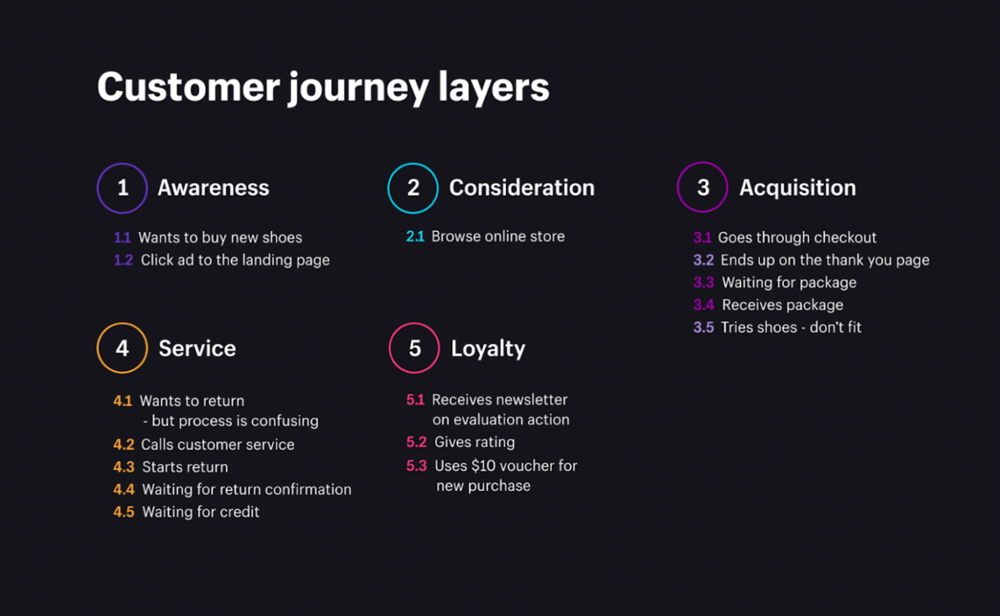
Throughout their journey, the customer makes contact with your brand. All these little moments, or so-called touchpoints, leave a positive or negative impression with the customer. If you are serious about customer retention, it is of course very much in your interest to make sure all these touchpoints are positive.
Hence, you might want to start the practice of ‘Customer Journey Mapping’: regularly putting yourself in your customers’ shoes and visualising their journey to find out what they experience, and where there is room for improvement. When do you communicate with your customer? How would you like that communication to go? What is important for your brand? How can you make things better for your customer, at every step of their journey? How can you help them reach their goals in a fast and easy manner?
Mapping your customer journey in some detail will definitely leave you with a long list of things to improve - and eventually lead to a lot of happy customers!
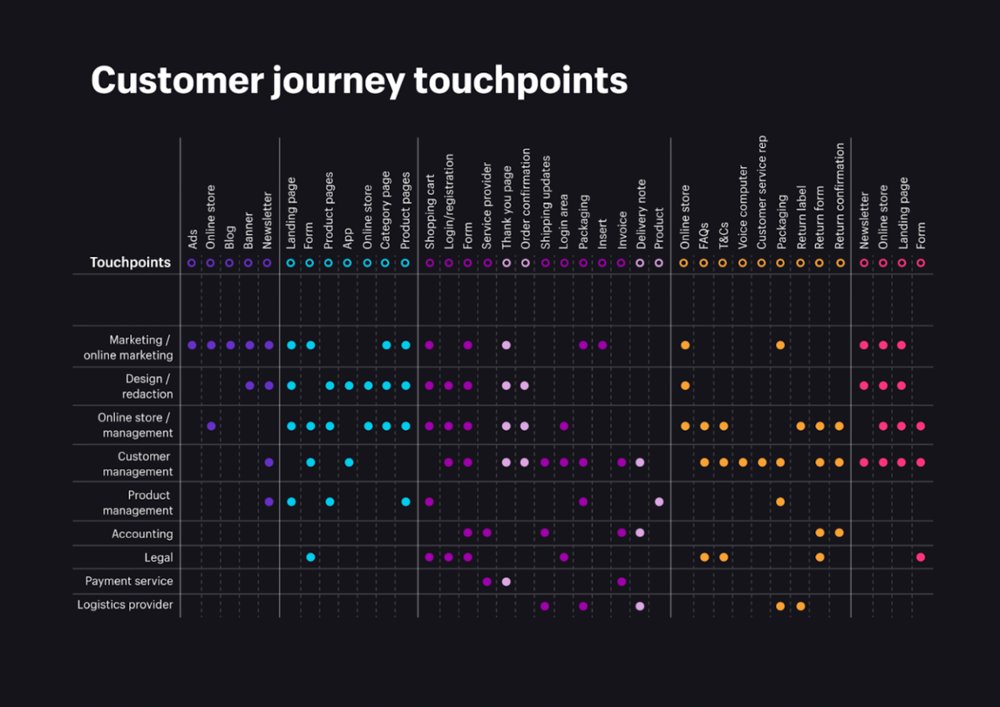
Tip 14: Offer excellent support and service
Like we already touched upon earlier in this blog: A time-honoured way to improve customer experience is to offer excellent service. Irrespective of the product, good service can inspire trust: it will determine if a customer will be a regular, if they will choose you over your competitors and if they will recommend you to friends and family. Here is a diagram to illustrate how much impact good service has on your customer retention:
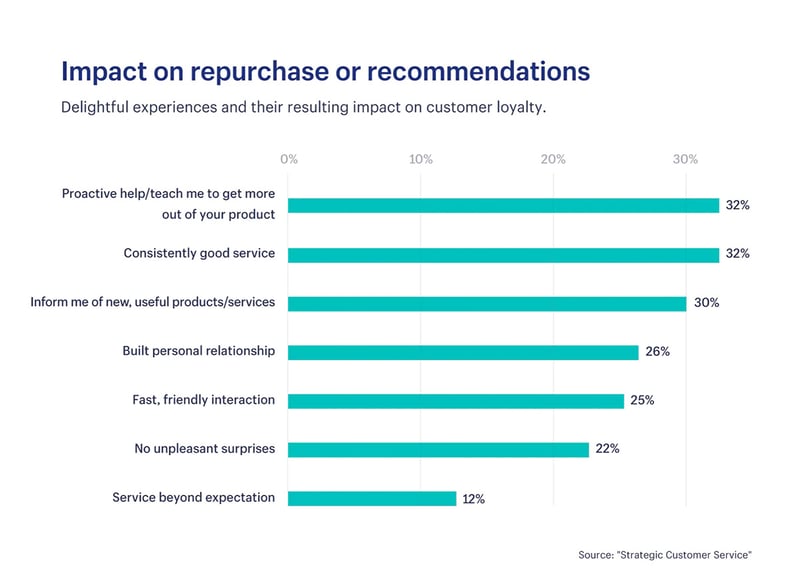
For this reason, it is crucial to have the right people manning your support desk, live chat or wherever else your customers go with questions and issues. People who know how to make a customer feel heard, and what tone to use with which customer. People who can turn a question into a purchase, a complaint into a solution, a frustration into a clear explanation - and a grumpy customer into a happy, loyal fan.
Of course a good help desk is not something you build overnight, especially not in an age when omnichannel marketing is becoming a necessity. Lucky for you, in modern times offering good service also depends on using the right software: something that gathers a customer’s cross-channel history in one place and allows personalised responses. Different people react in different ways: personalised responses isn’t just another trend, it’s a way to build a relationship with your customers and win their trust. Speed is an important factor too, because every extra minute spent waiting is a customer lost.
With specialised software, you can take the guesswork away from customer interaction and save valuable time (and customers!). At Code we highly recommend Gorgias for this: it gives your customer care people a centralised view of all the interactions you ever had with a customer, on all channels, so that they can provide the right support, fast. What’s more, Gorgias can automate recurring tasks, to ensure the customer doesn’t have to wait long for an answer.
The next step in getting better customers
Now off you go trying out some of these tips on your own business! If you could use a little help from an expert, don’t hesitate to reach out to us.
Want to learn more about the other levers in our e-commerce growth formula? Then we recommend you to keep reading because this series of blogs isn’t over yet. We’ve got two more in-depth articles in store for you, again with lots of actionable tips and tricks! The next one in this series is about improving your Average Order Value: click the link below to enter the wonderful world of upselling and cross-selling…
- 14 cross-sell and up-sell strategies to increase your Average Order Value (AOV)
- 16 tips on how to get more of your ideal customers - on improving Conversion




